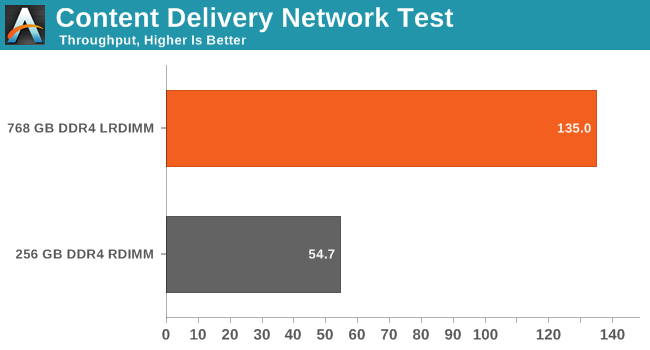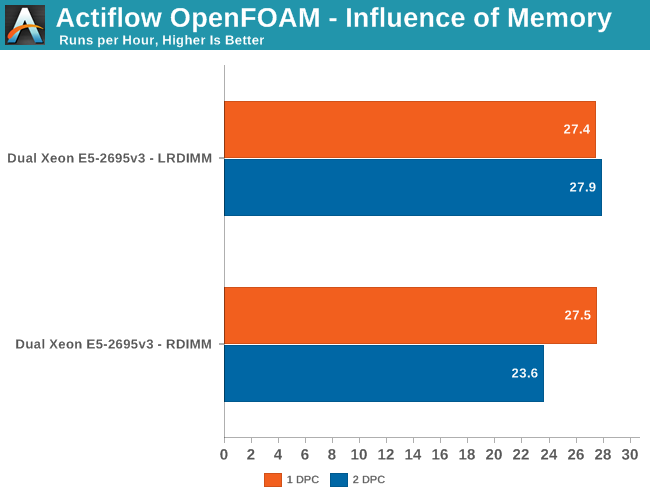Intel Xeon E5 Version 3: Up to 18 Haswell EP Cores
by Johan De Gelas on September 8, 2014 12:30 PM ESTLRDIMMs: Capacity and Real World Performance
As we have shown that Intel invested a lot of time to improve the support for LRDIMMs, we also wanted to do a few real world tests to understand when capacity or higher speed at high DPC matters.
First we test with our CDN test. We simulate our CDN test with one CDN server and three client machines on a 10 Gbit/s network. Each client machine simulates thousands of users requesting different files. Our server runs Ubuntu 13.04 with Apache.
The static files requested originate from sourceforge.org, a mirror of the /a directory, containing 1.4TB of data and 173,000 files. To model the real world load for the CDN two different usage patterns or workloads are executed simultaneously, one that accesses a limited set of files more frequently and a second that accesses less frequently requested files. This workload simulates users that are requesting both current as well as older or less frequently accessed files. You can read more about our CDN test here. We used the Xeon E5-2695 v3.

There is no doubt about it: some applications are all about caching and LRDIMMs are incredibly useful in these situations. Some HPC workloads supposedly require a lot of memory as well and can be very sensitive to memory bandwidth. Really? Even with a 35MB L3 cache? We decided to find out.

LRDIMMs are just as fast as RDIMM in a 1DPC configuration. Once you plug in two DIMMs per channel, LRDIMMs outperform RDIMMs by 18%. That is quite surprising considering that our CPU is outfitted with an exceptionally large L3. This test clearly shows there are still applications out there craving more memory bandwidth. In the case of OpenFOAM, the amount of bandwidth largely determines how many cores your CPU can keep busy.










85 Comments
View All Comments
cmikeh2 - Monday, September 8, 2014 - link
In the SKU comparison table you have the E5-2690V2 listed as a 12/24 part when it is in fact a 10/20 part. Just a tiny quibble. Overall a fantastic read.KAlmquist - Monday, September 8, 2014 - link
Also, the 2637 v2 is 4/8, not 6/12.isa - Monday, September 8, 2014 - link
Looking forward to a new supercomputer record using these behemoths.Bruce Allen - Monday, September 8, 2014 - link
Awesome article. I'd love to see Cinebench and other applications tests. We do a lot of rendering (currently with older dual Xeons) and would love to compare these new Xeons versus the new 5960X chips - software license costs per computer are so high that the 5960X setups will need much higher price/performance to be worth it. We actually use Cinema 4D in production so those scores are relevant. We use V-Ray, Mental Ray and Arnold for Maya too but in general those track with the Cinebench scores so they are a decent guide. Thank you!Ian Cutress - Monday, September 8, 2014 - link
I've got some E5 v3 Xeons in for a more workstation oriented review. Look out for that soon :)fastgeek - Monday, September 8, 2014 - link
From my notes a while back... two E5-2690 v3's (all cores + turbo enabled) under 2012 Server yielded 3,129 for multithreaded and 79 for single.While not Haswell, I can tell you that four E5-4657L V2's returned 4,722 / 94 respectively.
Hope that helps somewhat. :-)
fastgeek - Monday, September 8, 2014 - link
I don't see a way to edit my previous comment; but those scores were from Cinebench R15wireframed - Saturday, September 20, 2014 - link
You pay for licenses for render Nodes? Switch to 3DS, and you get 9999 nodes for free (unless they changed the licensing since I last checked). :)Lone Ranger - Monday, September 8, 2014 - link
You make mention that the large core count chips are pretty good about raising their clock rate when only a few cores are active. Under Linux, what is the best way to see actual turbo frequencies? cpuinfo doesn't show live/actual clock rate.JohanAnandtech - Monday, September 8, 2014 - link
The best way to do this is using Intel's PCM. However, this does not work right now (only on Sandy and Ivy, not Haswel) . I deduced it from the fact that performance was almost identical and previous profiling of some of our benchmarks.